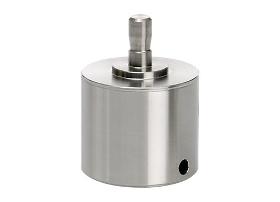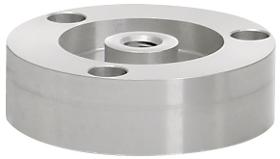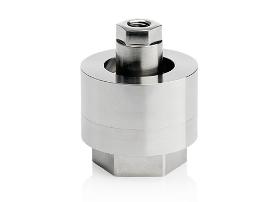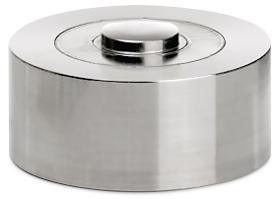- europages
- >
- COMPANIES - SUPPLIERS - SERVICE PROVIDERS
- >
- compression load cells
Results for
Compression load cells - Import export

BURSTER PRÄZISIONSMESSTECHNIK GMBH & CO KG
Germany
The load cell measures the compression forces between the circular contact surfaces of plunger and tool. The pin on its top side and hole on its lower face are simply provided for mechanical fixing and centering the components correctly. To provide as large a range of mechanical compatibility as possible, the pins/holes are available in different diameters. Attachments are available which clamp onto the press sensors to enable easy mounting of displacement sensors according to the circumstances of use. FEATURES: — Measuring ranges from 0 … 100 N up to 0 … 25 kN — Small, compact design — Pin/hole diameter from 8 mm to 16 mm — Different diameter for pin and hole can be combined — Mechanical overload protection for all measurement ranges
Request for a quote
BURSTER PRÄZISIONSMESSTECHNIK GMBH & CO KG
Germany
This force measurement chain was developed for applications where a low cost solution is more important than achieving high levels of accuracy. The sensors strain gauge technology allows the measurement of static and dynamic forces. The load cell is also designed for applications that provide only little space due to its compact design. These properties, together with the sensors dust protection, make the measuring chain suitable for a wide range of applications, such as Industrial manufacture Manufacture of customized machinery Geological investigations Motor vehicle engineering Commercial agriculture Bridge building The body of the sensor is a flat, cylindrical disk, into which a domed force application knob is integrated. It is important that the force is applied axially to the center of the sensor. The domed form, however, minimizes the effect of a force that is not exactly axial.
Request for a quote
BURSTER PRÄZISIONSMESSTECHNIK GMBH & CO KG
Germany
The tension & compression load cells from the 8523 series are designed for a wide range of uses. The sensors feature many benefits, including three point-contact mounts for tilt-free installation. Thanks to this feature, excellent measurement results can be achieved even with a sub-optimum mounting surface. The force to be measured is applied to the central threaded hole in the tension or compression direction. For measuring purely compressive loads, using load buttons from our accessories range saves the need for complex sensor-integration mechanisms. Tensile loads in rods or chains can also be detected with ease using the optional pull plate. Inside the sensor is an elastic membrane, on which are applied strain gages connected in a full Wheatstone bridge. FEATURES Measuring ranges from 0 ... 20 N to 0 ... 5 kN Tilt-free installation thanks to point-contact mounts Excellent price/performance ratio Easy mounting burster TEDS optionally available
Request for a quote
BURSTER PRÄZISIONSMESSTECHNIK GMBH & CO KG
Germany
The tension and compression load cell model 8435 enables universal and fast installation, requires hardly any installation space and upgrades with technical data that are readily achieved by larger sensors. Due to its excellent price-performance ratio with regard to its mechanical and electrical data, the force sensor finds its place in products that are also manufactured in larger quantities and calculated with a small budget. This model of load cell uses proven strain gage technology to perform measurements. Strain gages are applied to the sensitive element and connected to form a full bridge. FEATURES Measuring ranges from 0 ... 200 N up to 0 ... 5000 N Small dimensions Inexpensive execution Stable anti-kink protection Made of high quality stainless steel Connecting cable suitable for drag chains burster TEDS optionally available
Request for a quote
BURSTER PRÄZISIONSMESSTECHNIK GMBH & CO KG
Germany
The model 8527 high-precision compression load cell is the ideal load cell for reference measurement chains where highly precise measurement results are required. Its very high production quality and extremely low non-linearity of just 0.035 % F.S. make it a dependable choice for comparative measurements and calibration tasks. Designed for a dynamic stress of up to 100 % of the full scale value, the model 8527 load cell is also suitable for situations where a rapid signal change with high amplitude occurs and has to be measured. The model 8527 high-precision compression load cell has a domed load button on top, onto which the compressive load being measured is applied. Inside the load cell is an elastic membrane, on which strain gages generate a resistance change in the measuring bridge and an output signal proportional to the load. For the best possible measurement results, the force should be applied axially and centrically to the load button.
Request for a quoteDo you sell or make similar products?
Sign up to europages and have your products listed

BURSTER PRÄZISIONSMESSTECHNIK GMBH & CO KG
Germany
This low cost tension/compression load cell is an especially robust component, which can be easily integrated in a girder assembly between two cables or chains for measuring force. The standard model comes with internal thread, allowing any adapter parts, for instance eye brackets, to be fitted in the axis of symmetry. Alternatively, the optionally available adapters with external thread can be used for quick and easy screw-fitting into a threaded hole made for the purpose. The radial connection cable is extremely flexible and designed for a wide range of motion. In order to achieve the greatest possible stability for such a small sensor, making it suitable not only for the laboratory but also for industrial use, all parts have been welded together including the cable guide bush in the sensor housing. burster TEDS with an electronic sensor datasheet or standardization of the output signal in the sensor connecting cable are offered as options
Request for a quote
BURSTER PRÄZISIONSMESSTECHNIK GMBH & CO KG
Germany
Thanks to its compact shape and three fixing holes on its underside, the 8526 compression load cell can be used in a variety of applications. With its wide choice of measuring ranges from 0 ... 100 N up to 0 ... 1 MN, it really can cover a wealth of measurement tasks, from the laboratory to use in heavy industry. The integral load button provides an easy and reliable means of applying the force to be measured. Angle errors in the load application with a deviation from the measurement axis of up to 3° have only a minor influence on the measurement signal. For ideal measurement accuracy, the load cell should be mounted on a surface that has been ground and has a hardness of at least 60 HRC. The model 8526 load cell is designed with an internal elastic membrane, to which strain gages are attached. When a compressive load is applied to the load cell, the membrane is elastically deformed and transfers its tension to the strain gages.
Request for a quote
BURSTER PRÄZISIONSMESSTECHNIK GMBH & CO KG
Germany
Load cell model 8417 measures the tension or compression force between both axially mounted metric exterior threads on the cylindrical sensor housing. Forces are only applied to the threadings, which are especially long, to accommodate counter nuts and must not be affected by external influences such as bending, lateral force or torsion. Any contact with units affixed to the sensor housing - even on the front - must be avoided. The measurement element is a membrane perpendicular to the axis of the sensor with a strain gage full bridge applied to the inner surface, which requires stable excitation with a rated value of approx. 1 mV/V. The connection cable is led radially out of the housing through a sleeve which is used for strain relief. FEATURES: —Measuring ranges from 0 ... 10 N to 0 ... 5 kN —Very small dimensions —Made of stainless steel —Rugged construction —Simple screw mounting —burster TEDS optionally available
Request for a quote
BURSTER PRÄZISIONSMESSTECHNIK GMBH & CO KG
Germany
These models are among our most precise and yet mechanically robust miniature load cells. High accuracy, finely graded measuring ranges, small dimensions and the simple introduction of force via opposing threaded pins open up a wide scope of laboratory and production applications. Their sophisticated engineering with integrated support membranes and overload protection reduces additional design expense in many applications, e.g. for external overload protection or guiding the parts introducing force to the cell. The result is that less space is required, less material is used and less weight is involved. Last but not least, there is hardly any friction on components that could falsify the measurement result. The force to be measured is introduced centrally and axially to the cylindrical sensor body in the tension or compression direction by means of the two threaded pins. This requires the sensor to be mounted without any elements touching the end faces of the sensor housing.
Request for a quote
BURSTER PRÄZISIONSMESSTECHNIK GMBH & CO KG
Germany
The measuring element of this load cell consists of a double bending beam with strain gauges, the resistance of which changes with the application of force. Upon applying a voltage to the strain gauge bridge, the change in the strain gauge resistance is converted into output voltage, which is directly proportional to the force. The strain gauges and the entire measuring element are protected from water spray by metal cover including sealing material. The tensile or compressive load to be measured is applied to the sensor element through the M6 threaded hole located on each end face. The load can be applied easily, along the sensor axis. This serves to prevent falsification of the measured values. Overload protection can be realized with little effort using a mechanical stop. FEATURES Measuring ranges from 0 … 20 N to 0 … 880 N Relative non-linearity: ±0.25 % F.S. Many load cycles Protection class IP54 Excellent price-performance ratio burster TEDS optionally available
Request for a quote
BURSTER PRÄZISIONSMESSTECHNIK GMBH & CO KG
Germany
Due to their extremely compact design, these load cells can be used wherever static or dynamic load forces have to be measured in very tight spaces. Model 8416 is perfect for use in micro-technology and just as suitable for measuring tasks in the research and development sector. The ultra-miniature compression load cell model 8416 is a flat, circular disc, the bottom of which is sealed with a cover. The load application button for receiving the compression forces is an integrated part of the sensor. The sensor element inside the body carries a strain gage full bridge which outputs voltage directly proportional to the measurement variable upon application of force. The short nominal measurement distance of the ultra-miniature compression load cells due to their design provides a high degree of rigidity. If needed, the nominal characteristic value can be standardized in the sensor connection cable.
Request for a quote
BURSTER PRÄZISIONSMESSTECHNIK GMBH & CO KG
Germany
The measuring element of the load cell consists of a double bending beam on which strain gages are applied. The applied force detunes the measuring bridge so that a proportional output voltage is generated. The strain gages on the measuring element are protected against dirt and water spray by a rubber bellows. The sensor can be easily mounted via two mounting holes. The tension or compression force to be measured is introduced at the opposite end perpendicular to the sensor axis. Due to its special design, the influence by an extension (e.g. touch finger) on the measuring signal is low. Overload protection can be realized with little effort using a mechanical stop. FEATURES For tension and compression forces Measuring ranges from 0 ... 5 N to 0 ... 2 kN Relative non-linearity: ≤ ±0.1 % F.S. Very low mounting height Simple force application Material aluminium or stainless steel Special design on request burster TEDS optionally available
Request for a quote
BURSTER PRÄZISIONSMESSTECHNIK GMBH & CO KG
Germany
With its flat construction this force sensor is specially designed to be fitted to a pedal. By this, the operator's forces for each respective action, for example brake tests, can be measured directly and the reaction of the vehicle or machine can be designated. This applies to real test drives, as well as in driving simulators. Due to the special construction of the membrane, it is irrelevant whether an upright or hanging pedal is concerned. The sensor is designed in a way that unavoidable lateral forces have as little impact on the measurement result as possible. Using a central internal thread on the control surface, various machine-related adaptor parts can be easily mounted. Because the pedal is convex-shaped on its surface, the pedal force sensor has a very rigid base plate and therefore can easily be applied to various geometrics. The mounting can even take place on a pedal with an elastomer covering.
Request for a quote
BURSTER PRÄZISIONSMESSTECHNIK GMBH & CO KG
Germany
The sensor element consists of a double bending beam with applied strain gages. Changes in the ohmic resistance of the strain gage fullbridge caused by applied forces are converted into electrical voltages. The precise value (characteristic value) of the output voltage, resulting from the application of a rated force to the sensor, is specified in the accompanying calibration protocol. The sensor has to be mounted by two screws on the cable side. The opposite side is meant to receive applied forces (loads). Once the rated stress or strain is exceeded by 20 %, further deflection of the bending beam is prevented by an integrated, mechanical stop. This protects the sensor element against permanent deformation.
Request for a quote
BURSTER PRÄZISIONSMESSTECHNIK GMBH & CO KG
Germany
Due to their small dimensions and sturdy construction, these miniature compression load cells made of stainless steel can be used in a wide range of industrial applications and in laboratories. This compression load cell is easy to handle and its installation is uncomplicated. Its small size makes it perfect for use in very restricted structures for both static and dynamic compression force measurements. The miniature compression load cell model 8415 is a flat cylindrical disc, the bottom of which is closed with a cover. The load application button for receiving the compression forces is an integrated part of the sensor. A strain gage full bridge is applied in the gauging member of the measuring element. This produces bridge output voltage directly proportional to the measured force. The small diameter of the sensors results in high rigidity and a short measurement range. The measuring force has to be applied centrically and free from lateral forces.
Request for a quoteResults for
Compression load cells - Import exportNumber of results
16 ProductsCompany type
Category